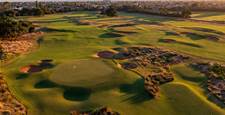The approach to Cypress Lakes leaves you in no doubt that you’re in hardcore wine country.
The vines reappear at the par-5 6th, whose fairway swoops down from the tee and back up again to the green. After a brace of drive-and-pitch par-4s at the 7th and 8th – where it must be noted that your reviewer made what must be one of the luckiest birdies the game, or more accurately, one of my playing partners, has ever seen – the front nine closes out on a tough par-4, the no.1 index hole. It’s a long hole, but position on the drive here is just as important as length, with a single gum in the left half of the fairway defining the line in. The 9th marks the change of the character in the course from the open landscape to the parkland style, as a thick strand of trees frame a narrow, back-to-front sloping green.
The 11th is a picture par-3, no more than 140 metres over a dip to a shallow green, formerly distinguished by a sharp ridge in the middle. That has since been flattened, but the steep bulkhead left – maybe a good 20 feet down – has not changed.
Like the 5th, the 12th has come in for change. This was one of the memorable holes of the course, for the fact you were likely to lose balls as much as anything. It was a long par-4, 400 metres even from the visitor plates, with a drive coming out of a narrow chute to what appeared to be a sliver of fairway – in reality, three tiers of short grass which widened as you went right. It’s been re-formulated as a par-3, played downhill from the highest point of the fairway, turning it into a long one-shotter that’s still plenty difficult.
The old 1st arrives now at the 14th, a better place in the round for such a hole. The long hitters might find it reachable after a good drive, but they’ll be made to think about laying up, with the slope at the front of the two-part green unlikely to allow anything to roll in.
Related Articles

Review: Omaha Beach Golf Club

Drinks With... Ricky Ponting









_15th_hole.jpg&h=115&w=225&c=1&s=1)




